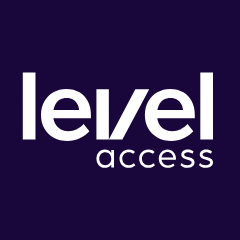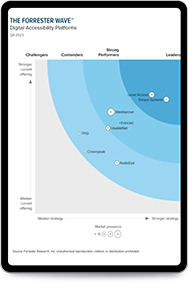Accessible Design Principles and Heuristics: The Story Behind the Guide
Oct 31, 2023
By Karen Hawkins, Principal of Accessible Design, Level Access
For decades, digital accessibility work has been reactive—it’s been about fixing something after it’s broken. In recent years, much progress has been made to combat this legacy problem with concepts like “shift left,” where design and development teams are encouraged to catch accessibility bugs earlier in their process by testing for accessibility as experiences take shape. But while this type of proactive testing is important, and certainly preferable to the outdated, status-quo approach of addressing accessibility issues after an experience is live, “shifting left” by itself fails to address the root cause of these issues. It’s still a reactive perspective that’s about testing to catch bugs, things that are already broken, rather than avoiding them in the first place.
It’s time for a shift in thinking (see what I did there…?). It’s time for a broader approach. It’s time for teams to be proactive about when, where, and how they apply digital accessibility to their work, not just as a “quality check” but as a guiding philosophy. As I’ve advocated elsewhere, accessibility needs to be thought about as the flour in the muffins, as it were—an integral, inextricable part of all experience creation.
Of course, this expanded approach puts designers in the hot seat, since “experience creation” often begins, in earnest, in design. But in my experience, very little exists for designers and content creators to lean on when it comes to applying digital accessibility proactively in their daily work. There are plenty of tools that can help designers check and adjust designs for certain aspects of accessibility, covering a subset of their scope, but what designers are lacking is a single source of truth to help them easily identify and understand all their responsibilities when it comes to ensuring accessibility. In short, designers need support for how to bake with accessibility instead of checking for it after the muffins (substitute your favorite baked good) are done.
Those who are “in the know” about digital accessibility may hesitate here. “What about WCAG?” you may ask. Certainly, the Web Content Accessibility Guidelines (WCAG) are an important standard that designers are, ultimately, accountable for upholding when shaping any digital experience. But the way WCAG is structured doesn’t align with the mental model used by most designers. We tend to think in terms of compentization and “flows,” which makes it convoluted and messy to refer back to WCAG. It’s not practical for designers to memorize long lists of specific success criteria and then try to cross-reference that mental list for which specific rules to apply to each new design. Designers just want to know what they need to consider from an accessibility standpoint, or if there’s anything they might be missing.
Introducing the Accessible Design Principles and Heuristics Guide
For years I’ve wanted to simplify WCAG and put it in designer-centric terms. So this year, I did. In an effort to arm designers and content creators with a resource they can use to proactively embed accessibility considerations in their regular workflows, I created the Accessible Design Principles and Heuristics Guide.
The guide includes more than 170 heuristics—think of them as guidelines or “to-do” statements—meant to help designers and content creators with their daily decisions. The heuristics are grounded in the technicalities of WCAG, as well as additional accessibility best practices, but they are presented in simple and understandable phrasing tailored to a creative audience.
But wait—there’s more. The heuristics are organized into designer-centric principles and sub-principles, making them easy to find and learn. In my opinion, the principles equate to the tenets of accessible design. For example, one principle, Properly Structure Elements, includes the following sub-principles:
- Clear Identification
- Logical Order
- Optimizing Assistive Technology Experience
- Proximity Implies Relationship
- Setting Context
- Setting User Up for Success
Designers are comfortable with and familiar with such concepts. One could easily map them to things like the 10 usability heuristics, the laws of UX, or other well-known usability guiding principles.
To create the heuristics, I referenced the robust set of design- and content-specific rules, based on WCAG, that I wrote for customers of Level Access’ Design Evaluations service. I simplified those rules and restructured them into more design-centric categories (the principles), and then included additional best practices.
And of course, like any good designer, I had my work reviewed. The heuristics were reviewed by my peers, Level Access’s Chief Accessibility Officer, Jon Avila, and our Chief Innovation Officer, Karl Groves. For a practitioner’s lens, I also had the heuristics reviewed by our product design team (including our design director, Swapnali Thakar) and members of our Design Evaluations testing team.
How to use the guide
The value of the guide is in helping designers and content creators identify the specific accessibility requirements for whatever task they have at hand, be that a component, pattern, page, flow, etc.
For example, a designer might be working on a new product card. They would consult the guide and find some heuristics that apply. They would then add these heuristics to their set of requirements, to be considered alongside all other requirements.
This is the future of design—where accessibility is included at the beginning, to be considered and incorporated alongside all other requirements.
But hey—I’m talking to designers here, so let me show the guide in action, rather than just describing its usefulness. In this quick video, I explain how the Accessible Design Principles and Heuristics can be applied to the common task of creating a product card.
Every designer’s practice is unique, and it would be naive to think one document can solve accessibility for any designer or their team. This guide is not meant to be thought of as a one-stop shop for all things accessible design.
Instead, my hope is that it’s a handy resource at the ready when designers need direction and guidance on accessibility, and ideally, a springboard to further knowledge-seeking and professional development in this area. If you’re a designer, I hope you refer to this document regularly to ensure the breadth and depth of accessibility coverage required in your designs. I also hope that, over time, the heuristics start to seem second nature, and that the principles help shape your individual design philosophy.
Make accessible design your new normal
If you’re ready to level up your daily design practice, you’re in good hands. Access the Accessible Design Principles and Heuristics Guide for the expert-informed, simplified direction you need to become an accessible design champion.
For more information on how Level Access can support you and your team with expert Design Evaluations and more, contact us.
About Karen Hawkins
Karen Hawkins is the Principal of Accessible Design at Level Access. She holds an honours Industrial Engineering degree with a specialization in Human Factors, and she is a certified accessibility professional. Karen worked for more than a decade as a user experience designer and director, leading and mentoring multidisciplinary teams in creating world-class user experiences and determining complex omnichannel digital solutions for leading global companies. She is a passionate advocate for digital accessibility, and she spends her time training both colleagues and clients to apply, and share, accessible design thinking.
Subscribe for updates


